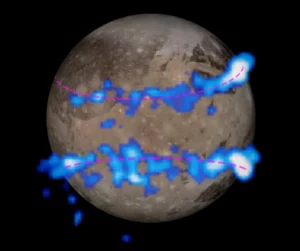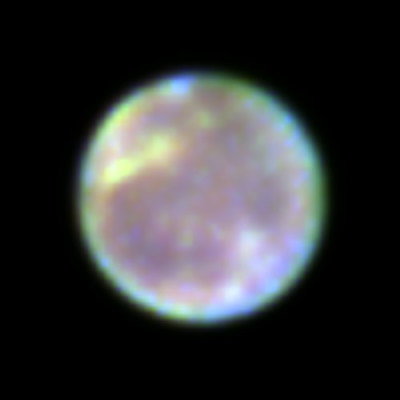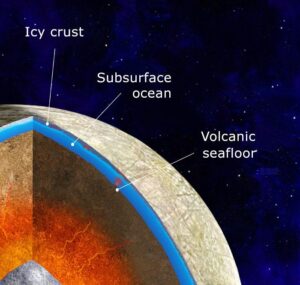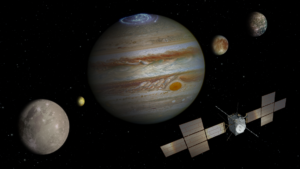Even though astronomers are busy exploring the exoplanets and far-off galaxies, much is still unknown about our universe. The immediate planets surrounding Earth have their own mysteries. As part of such mysteries, you have the biggest of all planets, Jupiter, with its own set of 80 to 95 moons. Among them, Ganymede the largest Moon, stands as the biggest in shape, compared to other Moons and some planets. For a fact it surpasses Mercury and Pluto in size.
In 1610, Galileo Galilei discovered Ganymede and three other large Moons orbiting Jupiter. The discovery eventually helped people understand how there are other planets in our solar system. And how all the planets are orbiting the Sun and not the Earth.
Moving on with the whereabouts of Ganymede the largest Moon, it is located at a distance of 665,000 miles from Jupiter. Third in the line after Io and Europa. Like other Moons, Ganymede is tidally locked, meaning the same side of the Moon always faces Jupiter. Over the years, space explorers and space crafts have come across multiple facts about Ganymede, which focuses on the Moon coming off with planet-like features. And here are them elaborated.
Ganymede The Largest Moon Has A Magnetic Field
In 1996, the Galileo spacecraft made a path-breaking discovery about Ganymede the largest Moon. The spacecraft detected Ganymede as the only Moon to have a magnetic field. Studies suggest – because Ganymede is located close to Jupiter, its magnetic field is embedded in or lies within the magnetic field of Jupiter. The Moon undergoes its own auroras due to the change in the gas giant’s (Jupiter’s) magnetic field. Appearing as ribbons of electrified gas, hot and glowing, specifically the North and the South pole.

Also, discoveries have bought to light how Ganymede has two different terrains—comprising bright and large ridges and grooves. The discovery suggests that the Moon’s crust has always been under tension because of global tectonic processes. The latest is NASA’s Juno spacecraft capturing the surface of the Moon during its flyby in 2021.
There Is A Thin Atmosphere
Ganymede, the largest Moon, has a daytime surface temperature of -147.22 degrees Celcius to -77 degrees Celcius, much colder than Earth’s. This is particularly true because of the Moon’s distance from the Sun. Also, the atmosphere of the natural satellite is quite thin, not a perfect one to be able to capture heat.

Discovering Ozone’s special fingerprint on Ganymede acted as a game-changer. Keith Noll and colleagues made quite a revelation over their observations of the Moon using the Hubble Space Telescope. They found a thin layer of Oxygen atmosphere, which probably comes from the moon’s icy surface.
Ganymede Has A Subsurface Ocean, Along With Water Vapor In The Atmosphere
Another greatest discovery by the Hubble Space Telescope revealed the Moon with water trapped under its surface. The subterranean ocean has more water than one can find on Earth. The researchers followed the rocking motions of the two aurorae, determining a large amount of saltwater beneath Ganymede’s crust. Thus affecting the magnetic field. According to the scientists, the ocean is 60 miles thick. 10 times deeper than the oceans which exist on Earth. These water bodies remain buried under 95 miles of the moon’s crust, mostly made of ice.

Moving on, the researchers did re-evaluate the Hubble observations of the moon from the past two decades, and in 2021, they went on to find the presence of water vapor. As outlined in the study, the research team analyzed the previously found oxygen as water vapor. Scientists discovered that at noon, the Moon’s equator is warm enough for the Sun to chip away its icy crust and turn water into water vapor.
The JUICE (JUpiter ICy moons Explorer) Mission
As a planned mission by European Space Agency, the JUpiter ICy moons Explorer got launched into space on the 14th of April, 2023, with an arrival time of the 14th of July, 2031. It is the first large-class mission in the ESA’s Cosmic Visions 2015-25 program.

The explorer will spend three years collecting data at Jupiter and then move forward, observing its icy moons – Ganymede the largest moon, Europa and Callisto. NASA and ESA have come up together for the mission.
As part of the mission, the explorer i) the habitable zone – characterizing the icy shells, ocean, surfaces, environments, composition, and activity of Europa, Ganymede, and Callisto. ii) Also it will characterize the atmosphere of Jupiter, its magnetic environment, satellites, and ring system.
So that is all about Ganymede the largest Moon with its planet-like features. Though no one plans to fly off and settle down such far off on Jupiter’s Moon, but with technology evolving at such a pace, nothing is impossible.



